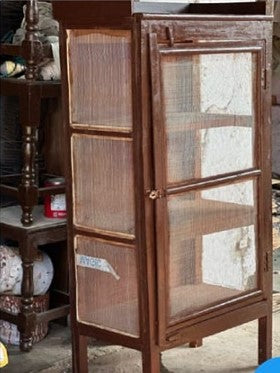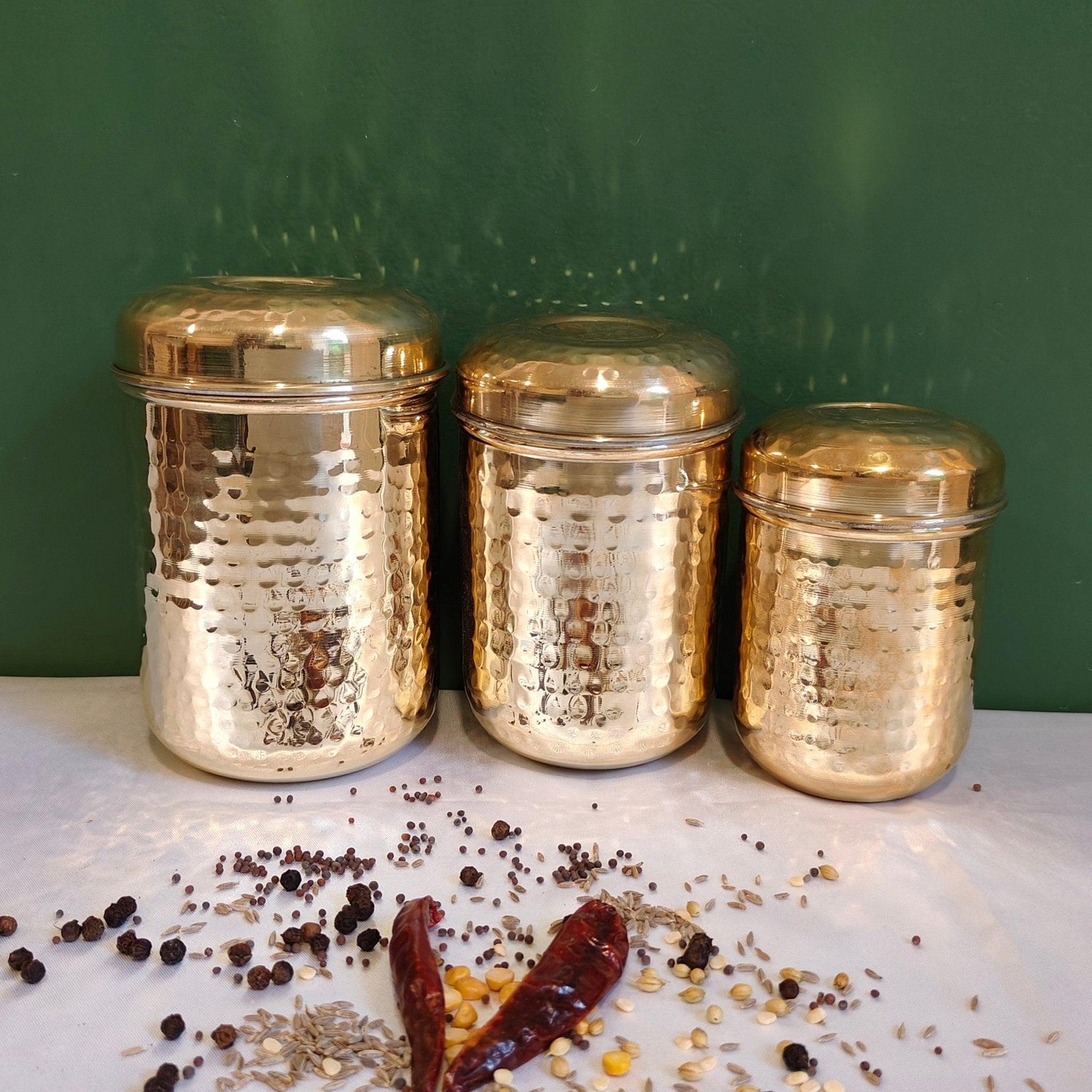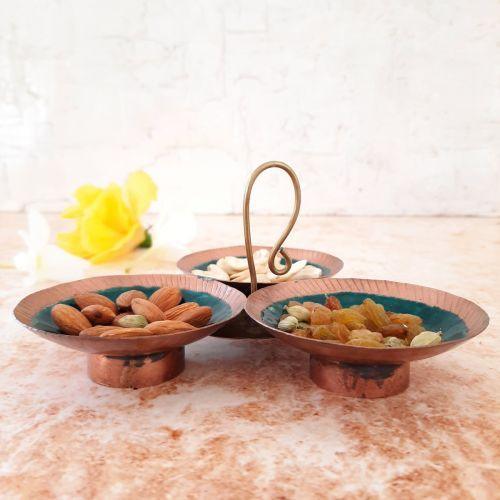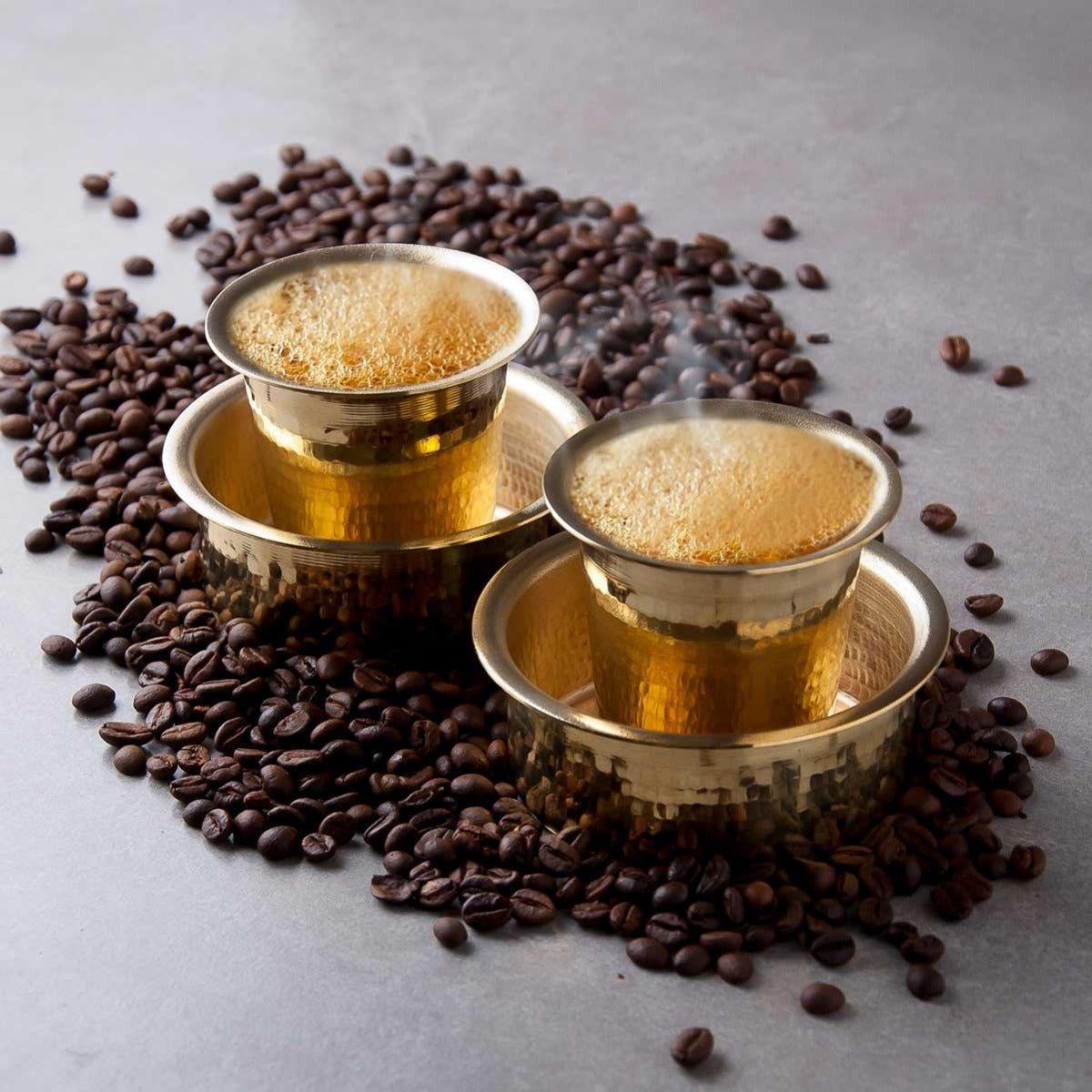Indian subcontinent has varied weather conditions from extreme summers to severe winters in certain parts of the country. Traditionally with no refrigeration concepts, we have been adept in coming up with very effective storage solutions for both cooked food and raw ingredients used in our daily lives.
In our good old days, you would have noticed a shelf in most grandmother’s home that is made of net/mesh of cane or coir. This is the oldest storage unit created to store cooked food overnight without getting spoilt.

Our ancestors would store cooked food in tin or brass vessels (With tin coating) overnight in these cupboards. The mesh provides effective air circulation. As the air flows through the small mesh holes, the air cools down and thereby keeping he temperature inside these cupboards lower than room temperature. Amazing, Isn’t it?
Different Traditional Storage Options:
There are several traditional storage options in Indian kitchens. Here are a few examples:
-
Masala Dabba: A Masala Dabba is a traditional Indian spice box used for storing commonly used spices. It typically has seven small containers with individual lids, which fit into a larger container with a tight-fitting lid. Masala Dabbas are often made of stainless steel and are a convenient way to store and organize spices.

- Bharani: Bharani is a traditional Indian ceramic jar used to store pickles, chutneys, and other preserves. The jar is typically cylindrical in shape with a narrow neck and a wide mouth. Bharanis are often glazed on the inside to make them impermeable to moisture and are available in a range of sizes. Also, soapstone is a great alternative that was used predominantly in south of India.
- Channi: A Channi is a traditional Indian strainer used for separating liquids from solids. It is typically made of brass or copper and has a flat, circular shape with a handle on one end. Channis are commonly used for straining curries, soups, and other dishes.
- Tiffin Boxes: Tiffin boxes are traditional Indian lunch boxes used for carrying food to work, school, or on journeys. They are typically made of brass with tin coating and have multiple compartments for different types of food. Tiffin boxes are often stacked on top of each other and secured with a handle or clip.

- Matki (Matka): A Matki is a traditional Indian earthen pot used for storing water. It is typically made of clay and has a narrow neck and a wide base. Matkis are commonly used in rural areas where there is no access to running water. The clay pot helps to keep the water cool and is believed to add minerals to the water.
Why brass is used for storage?
Brass is often used for storage in Indian kitchens because it is a durable and corrosion-resistant metal that can withstand high temperatures and is relatively easy to maintain. Brass is an alloy of copper and zinc, and it has antimicrobial properties that make it a popular choice for storing food items.
Brass is non-reactive with acidic foods, making it an excellent choice for storing pickles and other acidic food items that can react with other metals. It does not corrode or rust, even with prolonged exposure to moisture, making it a suitable option for storing liquids.
In addition to its functional properties, brass is also considered an auspicious metal in Indian culture and is often used for religious and decorative purposes. It is believed to have spiritual significance and is associated with wealth, prosperity, and good fortune.
Overall, brass is a versatile and practical metal that is commonly used for storage in Indian kitchens due to its durability, corrosion resistance, and antimicrobial properties.
Key Factors to consider while selecting brass storage
If you are considering using brass for storage in your kitchen, here are some key things to look for to ensure that you are purchasing a high-quality product:
- Material: Make sure the brass is made of high-quality materials that are food-grade and safe for storing food items. High-quality brass is usually a combination of copper and zinc and does not contain lead or other harmful metals.
- Finish: Look for a smooth and polished finish without any rough spots or blemishes. This will ensure that the surface is easy to clean and will not corrode or rust over time.
- Thickness: A thick layer of brass will ensure that the product is durable and long-lasting. Thin layers of brass may corrode and wear out quickly.
- Lids: If the brass storage item comes with a lid, make sure it fits tightly and securely to prevent air and moisture from entering. A tight-fitting lid will also help to preserve the freshness and flavor of the stored food items.
- Design: Consider the design and shape of the brass storage item. Look for a design that is functional, easy to use, and aesthetically pleasing.
- Care instructions: Ensure that the manufacturer provides care instructions for the brass storage item. Brass requires regular cleaning and maintenance to prevent tarnishing and discoloration, so it is important to know how to care for it properly.
By considering these factors, you can ensure that you purchase a high-quality brass storage item that will last for many years and provide a safe and attractive way to store food items in your kitchen.
Significance of Soapstone Storage
Soapstone is a natural, non-porous, and heat-resistant material that has been used for centuries in Indian kitchens for storage purposes. Here are a few ways soapstone can be used for storage:

- Spice boxes: Soapstone spice boxes are popular in Indian kitchens as they can store spices for a long time without losing their flavor or aroma. Soapstone is non-reactive with spices and helps keep them fresh by preserving their natural oils. The boxes often come with lids that fit tightly, preventing moisture from entering and spoiling the spices.
- Pickle jars: Soapstone pickle jars are also commonly used in Indian kitchens. The jars are airtight and help preserve pickles for a long time without getting spoiled. Soapstone's natural properties prevent odors from seeping into the pickle, and the jars can be easily cleaned.
- Tea and coffee storage: Soapstone can be used to store tea leaves and coffee beans due to its non-reactive properties. The material does not absorb moisture, so the aroma and flavor of the tea or coffee remain intact. The soapstone tea and coffee containers come with a tight-fitting lid that prevents air and moisture from entering.
Overall, soapstone is an excellent material for storage in Indian kitchens due to its natural properties, such as non-reactivity, non-porousness, and heat resistance. It can be used to store a variety of food items, including spices, pickles, tea, and coffee.
Advantages of Using Traditional Storage
Using traditional storage methods in the kitchen has several advantages, including:
- Preservation: Traditional storage methods help to preserve food items for a longer time without the need for refrigeration or chemical preservatives. For example, pickles stored in ceramic jars, and spices stored in brass containers can last for months without spoiling.
- Sustainability: Traditional storage methods are often made from natural materials such as clay, brass, and copper, which are eco-friendly and sustainable. They do not produce harmful chemicals that can harm the environment or human health.
- Health benefits: Traditional storage methods often use natural materials that have health benefits. For example, storing water in a copper vessel can help to kill bacteria and provide essential minerals to the body.
- Cost-effective: Traditional storage methods are often more cost-effective than modern storage methods. For example, storing grains in jute bags is more affordable than storing them in plastic containers.
- Aesthetic value: Traditional storage methods can add aesthetic value to the kitchen. They often come in unique designs and colors that can enhance the look of the kitchen and make it more attractive.
- Cultural significance: Traditional storage methods often have cultural significance and are an essential part of traditional cuisine. Using traditional storage methods can help to preserve and promote cultural heritage.
Overall, using traditional storage methods in the kitchen is a sustainable, cost-effective, and healthy option that can add aesthetic and cultural value to the kitchen.
How to Clean and Maintain Traditional Storage?
Cleaning and maintaining traditional storage items in the kitchen is essential to ensure that they remain hygienic, durable, and attractive. Here are some tips for cleaning and maintaining different types of traditional storage items:
- Brass: To clean brass storage items, mix equal parts of vinegar and water, and apply the solution to the surface using a soft cloth. After a few minutes, rinse the item with warm water and dry it with a clean cloth. To prevent tarnishing, apply a thin layer of oil or brass cleaner to the surface.
- Copper: To clean copper storage items, mix equal parts of salt and flour with enough vinegar to make a paste. Apply the paste to the surface of the copper and rub it gently with a soft cloth. Rinse the item with warm water and dry it with a clean cloth. To prevent tarnishing, apply a thin layer of oil or copper cleaner to the surface.
- Ceramic: To clean ceramic storage items, mix a few drops of dish soap with warm water and apply the solution to the surface using a soft cloth. Rinse the item with warm water and dry it with a clean cloth. To remove tough stains, mix baking soda with water to form a paste and apply it to the surface. Let it sit for a few minutes before rinsing it off.
- Wooden: To clean wooden storage items, wipe the surface with a damp cloth and mild soap. Rinse the item with warm water and dry it with a clean cloth. Avoid soaking the item in water or exposing it to heat. To maintain the wood's natural shine, apply a thin layer of vegetable oil to the surface.
- Jute: To clean jute storage items, wipe the surface with a damp cloth and mild soap. Rinse the item with warm water and dry it with a clean cloth. Avoid soaking the item in water or exposing it to direct sunlight. To prevent mold and mildew, store the jute item in a dry place.
By following these cleaning and maintenance tips, you can keep your traditional storage items in good condition and enjoy their functionality and beauty for years to come.
How to clean and maintain soapstone containers?
Soapstone is a soft and porous material that is commonly used for kitchen storage items like bowls and jars. Here are some tips on how to clean and maintain soapstone:
- Cleaning: To clean soapstone, use a mild dish soap and warm water to gently scrub the surface with a soft-bristled brush. Rinse the item with warm water and dry it thoroughly with a clean cloth. Avoid using harsh abrasives or cleaning products that can scratch or damage the soapstone surface.
- Stain removal: Soapstone is prone to staining, especially from acidic foods and liquids like vinegar and citrus juices. To remove stains, make a paste of baking soda and water and apply it to the stained area. Let it sit for several hours or overnight, then rinse the soapstone thoroughly with warm water and dry it with a clean cloth.
- Oil treatment: To maintain the natural beauty and durability of soapstone, it should be treated with castor oil. Apply a small amount of castor oil to the surface of the soapstone and let it absorb for several hours or overnight. Wipe away any excess oil with a clean cloth. Repeat this process once a month or as needed to keep the soapstone looking its best.
- Heat resistance: Soapstone is a good heat conductor, and it can withstand high temperatures without cracking or breaking. However, sudden temperature changes can cause soapstone to crack or break. Avoid placing hot items directly on soapstone surfaces, and always use trivets or potholders to protect the surface.
By following these tips, you can clean and maintain your soapstone kitchen storage items properly and ensure that they last for many years to come.
Don't miss to read The complete Guide to Soapstone Cookware !




1 comment
Vivek Raja
Well I am looking out for the utensils in my New join that is being opened in Blore ,Goa and Mangalore. Thanks
Leave a comment
All comments are moderated before being published.
This site is protected by hCaptcha and the hCaptcha Privacy Policy and Terms of Service apply.